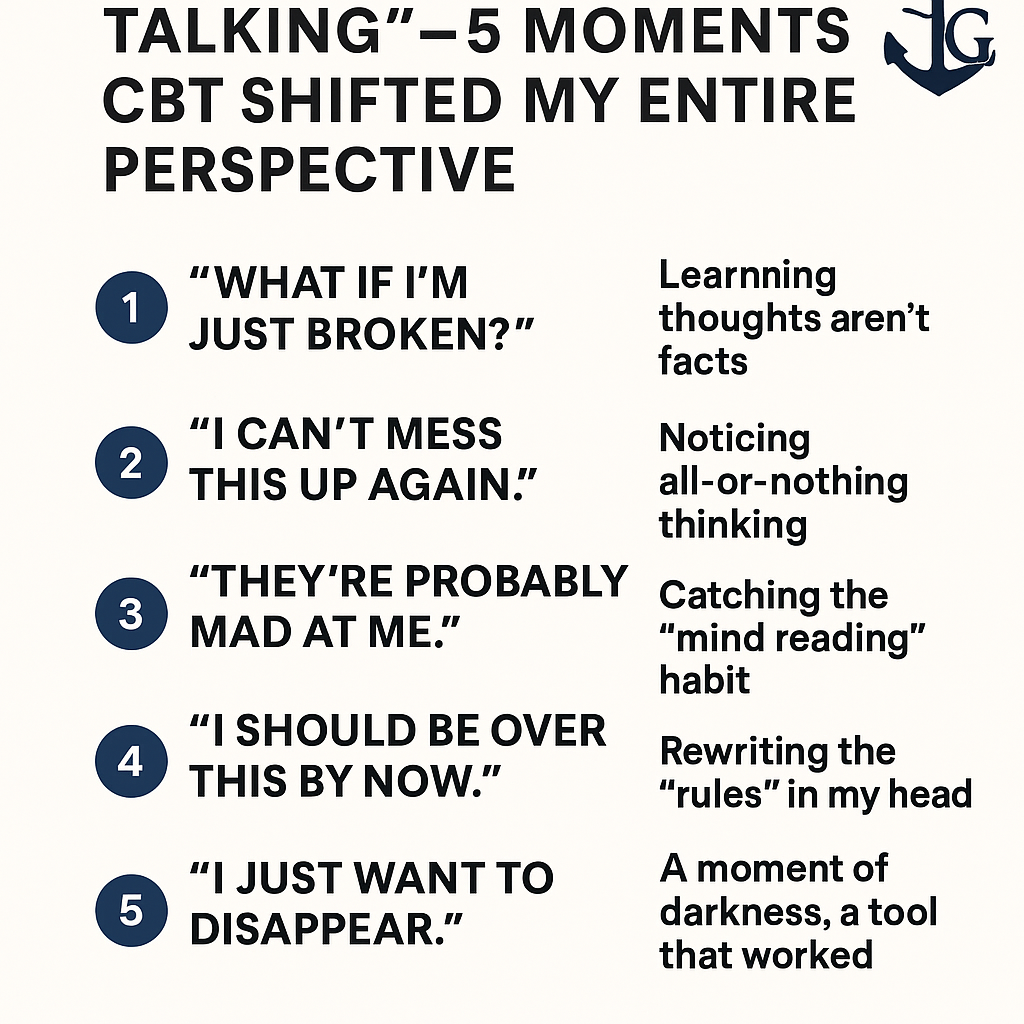If you’ve never been to therapy, here’s something I want you to know: I didn’t walk in confident. I didn’t trust it would work. I just felt stuck.
The idea of “talking about my feelings” felt awkward at best, useless at worst. But I showed up anyway—mostly because I didn’t know what else to do.
That’s when I learned that CBT—Cognitive Behavioral Therapy—isn’t just talking. It’s learning how to look at your thoughts differently, and it changed everything for me.
Here are five real moments where CBT helped shift my perspective—and made therapy feel like something I could actually use in my life.
1. “What if I’m just broken?”
CBT Moment: Learning thoughts aren’t facts
This was the first belief I said out loud in therapy. I didn’t even cry—it came out flat, like a statement of fact.
But instead of trying to make me feel better, my therapist wrote it down. “Let’s look at that,” she said.
We made a two-column list: the thought on one side, the evidence on the other. I couldn’t come up with a single real reason to prove I was broken. I had feelings, yeah. Struggles, sure. But not proof.
That’s when it hit me—just because a thought is loud doesn’t mean it’s true.
2. “I can’t mess this up again.”
CBT Moment: Noticing all-or-nothing thinking
Perfectionism was eating me alive. One mistake felt like total failure. And the pressure I put on myself? It kept me from even trying.
CBT gave that pattern a name: all-or-nothing thinking. Either I was perfect, or I was a failure. No in-between.
We practiced middle-ground thoughts like: “I can handle doing okay, not perfect.” That one sentence helped me show up for things I used to avoid—job interviews, hard conversations, even therapy itself.
3. “They’re probably mad at me.”
CBT Moment: Catching the “mind reading” habit
If a friend didn’t text back right away, I panicked. If my boss used a period in a message, I assumed they were angry.
CBT taught me to name that: mind reading. I was filling in blanks with worst-case scenarios. And those assumptions made me withdraw, cancel plans, even sabotage relationships that were actually solid.
Now, I pause. I ask myself, “Do I know this for sure?” Sometimes I’ll even send a clarifying message instead of ghosting. That shift alone brought me closer to people I care about.
4. “I should be over this by now.”
CBT Moment: Rewriting the “rules” in my head
I didn’t realize how many invisible rules I was living by. Rules like:
- You don’t get to ask for help twice.
- If you’re not improving, you’re failing.
- Only weak people need therapy.
CBT helped me pull those rules into the light. We called them “core beliefs,” and most of them were harsh, unforgiving, and totally unrealistic.
Instead of letting those rules run my life, I started replacing them with truths that were firm but kind. Like: “Healing isn’t linear—and neither am I.”

5. “I just want to disappear.”
CBT Moment: A moment of darkness, a tool that worked
This wasn’t poetic. It wasn’t cinematic. It was a Tuesday night, and I couldn’t stop crying. I told my therapist I didn’t want to exist anymore.
I expected pity or panic. But instead, we opened a CBT worksheet. Together, we tracked the thought, the feeling, the behavior.
That structure didn’t fix everything. But it gave me something to hold onto. It reminded me that even in my darkest moments, there were still tools I could use.
The Biggest Shift? Realizing CBT Isn’t a Fix—It’s a Framework
CBT didn’t magically make my anxiety go away or stop the hard days from happening. But it gave me language. It gave me a way to step outside the spiral, even for a moment, and see things with a little more clarity.
You don’t need to be “ready” to change your life. You just need to be willing to get curious about your thoughts. CBT can help with that—one worksheet, one question, one moment at a time.
💬 Frequently Asked Questions About CBT
What exactly is Cognitive Behavioral Therapy (CBT)?
CBT is a form of talk therapy that focuses on how your thoughts, feelings, and behaviors are connected. Instead of just unpacking the past, CBT helps you recognize unhelpful thought patterns and practice new ways of thinking that support your goals.
Is CBT just positive thinking?
Nope. CBT isn’t about pretending things are fine when they’re not. It’s about being honest with yourself—and learning to challenge thoughts that don’t serve you. It’s practical, not fluffy.
How long does CBT take to work?
Everyone’s different, but many people start noticing changes in how they think and feel within a few weeks. Some people use CBT short-term, others stay in therapy longer to keep building on the tools.
Do I have to do homework?
CBT often includes worksheets or exercises to try between sessions. It’s not about being graded—it’s about giving you tools you can use in real life, outside the therapy room.
Can CBT help with anxiety or depression?
Yes. CBT is one of the most researched and effective therapies for both anxiety and depression. It can also help with panic, OCD, trauma, and more.
📞 Ready to Take the First Step?
If any part of this felt familiar—if your brain feels like a loop you can’t turn off—CBT might be a good place to start.
You don’t have to have it all figured out. You don’t need a perfect plan. You just need a place to start feeling better.
Call us at (888) 685-9730. We’ll walk with you from here.








